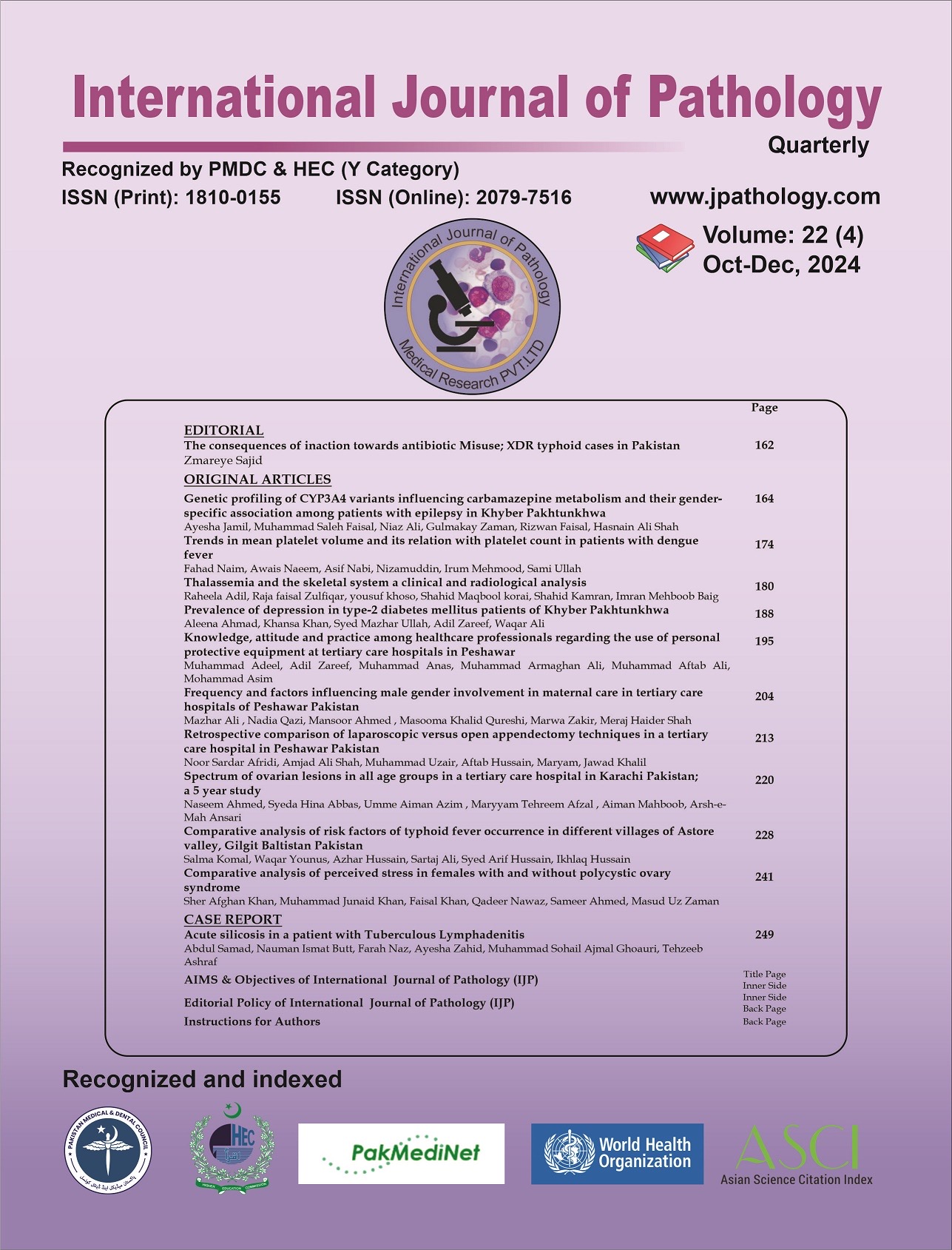Thalassemia and the skeletal system
a clinical and radiological analysis
DOI:
https://doi.org/10.59736/IJP.22.04.926Keywords:
Dexa Scan, Osteoporosis, Osteopenia, ThalassemiaAbstract
Background: Thalassemia can lead to various skeletal complications due to the effects of chronic anemia and iron overload. Common pathologies include bone deformities, osteoporosis, and fractures, particularly in the skull, long bones, and spine. Iron deposition in bones, coupled with abnormal bone marrow expansion, contributes to skeletal abnormalities. A comprehensive understanding of these skeletal manifestations is essential for improving management strategies and minimizing morbidity in thalassemia patients.
Methods: It was an observational case control study and was hospital based, executed at department of Hematology mainly in collaboration with Medicine, Radiology and Pathology departments of (RYK Hospital, Rahim Yar Khan). Commencement of study took place on 12th of March 2022 and concluded on 11th of June 2023. Forty (40) patients and forty (40) controls participated in study. The data obtained was scrutinized by statistical package for social sciences software (SPSS) version 24. Dual-Energy X-ray Absorptiometry (DEXA) scans were generated for every case and control.
Results: Our research found that people suffering from thalassemia have increased risk of weaker skeletal framework by -11.160 times at anatomical neck of femur and -6.670 times at vertebrae (lumbar) in comparison to controls. Cases versus control comparison of bone mineral density (BMD) also revealed a statistically highly significant difference also.
Conclusion: in light of our results, there is highly significant evidence that well above the half of the patients affected by thalassemia has weaker bones and should be evaluated and treated frequently for skeletal pathologies.
References
Ali S, Mumtaz S, Shakir HA, Khan M, Tahir HM, Mumtaz S, et al. Current status of beta-Thalassemia and its treatment strategies. Mol Genet Genomic Med. 2021 Dec;9(12):e1788. doi: 10.1002/mgg3.1788.
Lidonnici MR, Scaramuzza S, Ferrari G. Gene Therapy for Hemoglobinopathies. Hum Gene Ther. 2023 Sep;34(17-18):793-807. doi: 10.1089/hum.2023.138.
Carsote M, Vasiliu C, Trandafir AI, Albu SE, Dumitrascu MC, Popa A, et al. New Entity-Thalassemic Endocrine Disease: Major Beta-Thalassemia and Endocrine Involvement. Diagnostics (Basel). 2022 Aug 9;12(8):1921. doi:
3390/diagnostics12081921.
Anurogo D, Yuli Prasetyo Budi N, Thi Ngo MH, Huang YH, Pawitan JA. Cell and Gene Therapy for Anemia: Hematopoietic Stem Cells and Gene Editing. Int J Mol Sci. 2021 Jun 10;22(12):6275. doi:
3390/ijms22126275.
Zeng S, Lei S, Qu C, Wang Y, Teng S, Huang P. CRISPR/Cas-based gene editing in therapeutic strategies for beta-Thalassemia. Hum Genet. 2023 Dec;142(12):1677-1703. doi: 10.1007/s00439-023-02610-9.
Aprile A, Sighinolfi S, Raggi L, Ferrari G. Targeting the Hematopoietic Stem Cell Niche in β-Thalassemia and Sickle Cell Disease. Pharmaceuticals (Basel). 2022 May 11;15(5):592. doi: 10.3390/ph15050592.
Dighriri IM, Alrabghi KK, Sulaiman DM, Alruwaili AM, Alanazi NS, Al-Sadiq AA, et al. Efficacy and Safety of Luspatercept in the Treatment of β-Thalassemia: A Systematic Review. Cureus. 2022 Nov 16;14(11):e31570. doi: 10.7759/cureus.31570.
Kelley K, Preacher KJ. On effect size. Psychol Methods (2012)17(2):137–152
Sadiq IZ, Usman A, Muhammad A. et al. Sample size calculation in biomedical, clinical and biological sciences research. J.Umm Al-Qura Univ. Appll. Sci. (2024). Vol 10 https://doi.org/10.1007/s43994-024-00153-x
Lewiecki EM, Gordon CM, Baim S, Leonard MB, Bishop NJ, Bianchi ML, et al. International society for clinical densitometry 2007 adult and pediatric official positions. Bone 2008;43:1115-21.
Singh K, Kumar R, Shukla A, Phadke SR, Agarwal S. Status of 25-hydroxyvitamin D deficiency and effect of vitamin D receptor gene polymorphisms on bone mineral density in Thalassemia patients of North India. Hematology 2012;17:291-6.
Shamshirsaz AA, Bekheirnia MR, Kamgar M, Pourzahedgilani N, Bouzari N, Habibzadeh M, et al. Metabolic and endocrinologic complications in beta-thalassemia major: A multicenter study in Tehran. BMC Endocr Disord 2003;3:4.
Shah N, Mishra A, Chauhan D, Vora C, Shah NR. Study on effectiveness of transfusion program in thalassemia major patients receiving multiple blood transfusions at a transfusion centre in Western India. Asian J Transfus Sci 2010;4:94-98.
Nakavachara P, Weerakulwattana P, Pooliam J, Viprakasit V. Bone mineral density in primarily preadolescent children with hemoglobin E/β-thalassemia with different severities and transfusion requirements. Pediatr Blood Cancer. 2022 Sep;69(9):e29789. doi: 10.1002/pbc.29789.
Atmakusuma TD, Tenggara JB. Correlation of Transferrin Saturation and Serum Ferritin with Bone Mass Density in Adult Transfusion Dependent Beta-Thalassemia Patients. J Blood Med. 2021 Sep 9;12:827-832. doi: 10.2147/JBM.S328547.
Wiromrat P, Rattanathongkom A, Laoaroon N, Suwannaying K, Komwilaisak P, Panamonta O, et al. Bone Mineral Density and Dickkopf-1 in Adolescents with Non-Deletional Hemoglobin H Disease. J Clin Densitom. 2023 Jul-Sep;26(3):101379. doi: 10.1016/j.jocd.2023.101379.
Charoenngam N, Rittiphairoj T, Ponvilawan B. Fracture prevalence in thalassemia: a systematic review and meta-analysis. Arch Osteoporos. 2021 Nov 13;16(1):171. doi:10.1007/s11657-021-01026-0.
Gaudio A, Xourafa A, Rapisarda R, Zanoli L, Signorelli SS, Castellino P. Hematological Diseases and Osteoporosis. Int J Mol Sci. 2020 May 16;21(10):3538. doi: 10.3390/ijms21103538.
Ananvutisombat N, Tantiworawit A, Punnachet T, Hantrakun N, Piriyakhuntorn P, Rattanathammethee T, et al. Prevalence and risk factors predisposing low bone mineral density in patients with thalassemia. Front Endocrinol (Lausanne). 2024 Jun 24;15:1393865. doi: 10.3389/fendo.2024.1393865.
Das A, Dutta A, Taye P, Sharma A. Exploring the relationship between Thalassemia and bone health: A clinicopathological analysis. J Hematol Allied Sci. 2023;3:115-9. Doi 10.25259/JHAS_20_2023..
Downloads
Published
Issue
Section
License
Copyright (c) 2025 Raheela Adil, Raja faisal Zulfiqar, yousuf khoso, Shahid Maqbool korai, Shahid Kamran, Imran Mehboob Baig

This work is licensed under a Creative Commons Attribution-NonCommercial 4.0 International License.
Readers may “Share-copy and redistribute the material in any medium or format” and “Adapt-remix, transform, and build upon the material”. The readers must give appropriate credit to the source of the material and indicate if changes were made to the material. Readers may not use the material for commercial purpose. The readers may not apply legal terms or technological measures that legally restrict others from doing anything the license permits.


